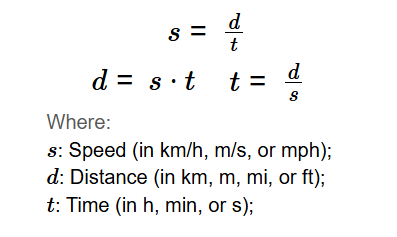 Home
Home
 Back
Back

At Speed Calculator, we provide precise and easy-to-use tools to calculate speed, distance, and time relationships. Whether you're solving physics problems, planning travel routes, or analyzing athletic performance, our calculator delivers instant calculations using the fundamental speed formula (Speed = Distance/Time). Designed for students, athletes, engineers, and travelers alike, Speed Calculator transforms complex motion calculations into simple, understandable results - helping you make quick and accurate assessments.
The calculator uses the following equations:
Where:
Steps:
Calculating speed is crucial for:
Example 1: Calculate the speed for a car traveling \( d = 100 \, \text{km} \) in \( t = 2 \, \text{h} \), result in km/h:
Example 2: Calculate the time to travel \( d = 5 \, \text{mi} \) at \( s = 60 \, \text{mph} \), result in min:
Q: What is speed?
A: Speed is the rate at which an object covers distance, calculated as distance divided by time (\( s = d / t \)).
Q: How is speed different from velocity?
A: Speed is a scalar quantity (magnitude only), while velocity is a vector (includes direction).
Q: Why must time or speed be positive for calculations?
A: Time and speed must be positive to avoid division by zero and ensure physically meaningful results.
Q: What units can I use?
A: Distance: km, m, mi, ft; Time: h, min, s; Speed: km/h, m/s, mph.
Q: How does the calculator handle unit conversions?
A: Inputs are converted to SI units (m, s, m/s) for calculation, then the result is converted to the selected output unit.
Q: Can I calculate average speed for multiple segments?
A: This calculator computes speed for one segment. For average speed over multiple segments, calculate total distance divided by total time separately.
Q: Why do I need to select what to calculate?
A: Selecting the calculation type ensures the correct inputs are provided and clarifies the desired output.
Q: Can this calculator handle zero speed?
A: Zero speed is valid for distance calculations (resulting in zero distance if time is non-zero) but not for time calculations (causes division by zero).
Q: How accurate is the calculator?
A: Accuracy depends on input precision and uses standard conversion factors (e.g., 1 mi = 1609.344 m).
Q: Can I use this for rotational speed?
A: No, this calculator is for linear speed. Rotational speed requires different formulas (e.g., radians per second).
Q: Why are results sometimes in scientific notation?
A: Results less than 0.001 are displayed in scientific notation for readability, per the calculator’s formatting.
Q: How can I use this for trip planning?
A: Select time calculation, input distance and speed to estimate travel time, or use speed calculation for average speed.
Q: Does this account for stops or varying speeds?
A: No, it calculates average speed for constant motion. Subtract stop times from total time for accurate results.
Q: Can I use this for running or cycling?
A: Yes, select speed calculation, input distance and time to find average speed, or time calculation for race duration.
Q: What is the fastest speed possible?
A: In physics, the speed of light (299,792,458 m/s) is the ultimate limit, but this calculator is for everyday speeds.